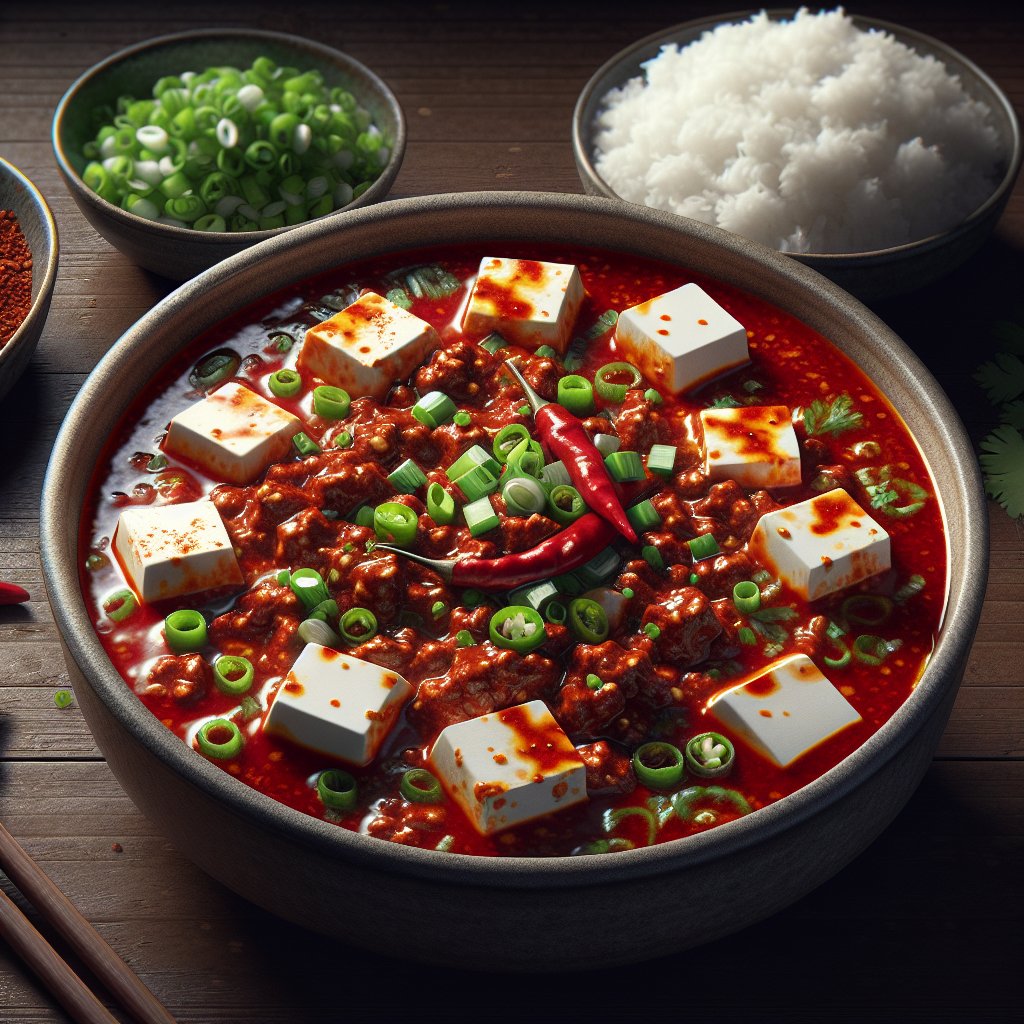Mapo Tofu: A Classic Sichuan Dish
Description:
Mapo tofu is a beloved dish in Chinese cuisine, particularly from the Sichuan region. It’s known for its spicy and numbing flavors, which come from a blend of chili oil, fermented black beans, and Sichuan peppercorns. The softness of the tofu contrasts beautifully with the fiery sauce, making it an unforgettable culinary experience.
Serving Size: 4 servings
Total Time: 30 minutes
Cooking Time: 15 minutes
Preparation Time: 15 minutes
Ingredients:
- 400g soft tofu, cut into cubes
- 3 tbsp vegetable oil
- 2 tbsp doubanjiang (fermented broad bean and chili paste)
- 1 tbsp Sichuan peppercorns, crushed
- 1 tsp sugar
- 1/4 cup chicken stock or water
- 2 tbsp Shaoxing wine (or dry sherry)
- 2-3 dried red chilies, cut into small pieces
- 50g ground pork (optional)
- 2 cloves garlic, minced
- 1 tsp ginger, minced
- 1 tbsp cornstarch mixed with 1 tablespoon water
- Sliced scallions for garnish
How to Cook:
- Prepare the Ingredients: Cut the tofu into cubes and set aside. Mince garlic, ginger, and slice scallions.
- Heat Oil and Doubanjiang: In a wok or large skillet over medium heat, add 3 tablespoons of vegetable oil. Once hot, stir in doubanjiang and cook for about 1 minute until fragrant.
- Add Aromatics: Add minced garlic and ginger to the wok, stirring well to combine with the doubanjiang paste.
- Cook Ground Pork (Optional): If using ground pork, add it now. Stir-fry until the meat is no longer pink and has a slightly crispy texture.
- Add Tofu: Carefully place the tofu cubes into the wok with the aromatics. Gently stir to avoid breaking the tofu.
- Cook Sauce: Pour in chicken stock or water, Shaoxing wine, and sugar. Bring to a simmer and cook for about 5 minutes until the sauce thickens slightly.
- Add Spices: Add crushed Sichuan peppercorns and dried red chilies. Stir well to combine with the tofu and sauce.
- Thicken Sauce: Slowly pour in the cornstarch mixture, stirring constantly until the sauce thickens to your liking.
- Garnish and Serve: Remove from heat and garnish with sliced scallions. Serve immediately over steamed rice or noodles for a complete meal.
Tips:
- If you prefer less spice, reduce the amount of dried red chilies or use milder varieties.
- For those who don’t eat meat, omit the ground pork and increase the quantity of doubanjiang for more flavor.
- The Sichuan peppercorns give a unique numbing sensation that complements the spiciness. If you’re sensitive to this taste, use fewer or substitute with black pepper.
History:
Mapo tofu has a rich history dating back over 100 years in Chengdu, Sichuan Province. Legend has it that the dish was created by a woman named Chen Mapo who ran a small restaurant and sold her signature spicy tofu dish to locals. The name “mapo” translates roughly as “pockmarked old lady,” referring to the cook’s appearance.
Variations:
There are many variations of mapo tofu across China, with different regions adding their own unique touches. In some areas, it might include additional vegetables like bell peppers or mushrooms for a heartier meal. Some versions also incorporate fermented soybeans or other types of chili pastes to adjust the flavor profile.
Pairing Suggestions:
To balance out the spiciness and richness of mapo tofu, serve with steamed white rice or noodles. A cold beer or a light green tea can help soothe the palate after enjoying this fiery dish.
Nutritional Information (per serving):
- Calories: 300 kcal
- Total Fat: 18g
- Saturated Fat: 2.5g
- Cholesterol: 15mg
- Sodium: 600mg
- Total Carbohydrates: 14g
- Dietary Fiber: 2g
- Sugars: 3g
- Protein: 12g
Storage:
Leftover mapo tofu can be stored in an airtight container in the refrigerator for up to three days. Reheat gently on the stovetop or microwave, adding a little water if necessary to maintain moisture.
Tips for Vegetarians and Vegans:
- Replace chicken stock with vegetable broth for a vegetarian version.
- Omit ground pork entirely for a vegan option. Increase the amount of doubanjiang to enhance flavor.
Serving Suggestions:
Mapo tofu pairs wonderfully with steamed buns or dumplings as an appetizer, followed by a simple stir-fried vegetable dish and a side of rice or noodles for a complete meal. For dessert, consider serving some sweet bean paste soup to balance out the spiciness.
Conclusion:
Mapo tofu is not just a dish; it’s an experience that encapsulates the bold flavors and culinary traditions of Sichuan cuisine. Its complexity in taste makes it one of China’s most celebrated dishes, enjoyed by food lovers around the world. Whether you’re a fan of spicy foods or new to this flavor profile, mapo tofu is definitely worth trying.

